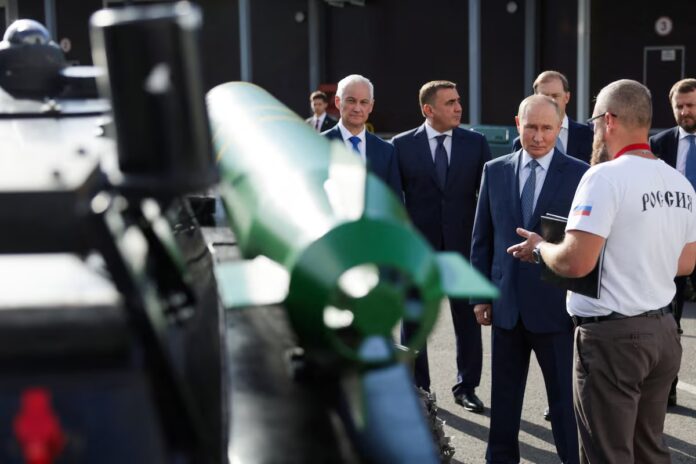Russia Increases 2025 Defence Spending by 25% to Highest Post-Soviet Level
Russia Hikes 2025 Defence Spending by 25% to a New Post-Soviet High
– Russia to spend 6.3% of GDP on national defence
– Highest level since the Cold War
– Defence spending at $145 billion, budget shows
– Defence spending a third of all spending
– Defence and security spending even higher
MOSCOW, Sept 30 (Reuters) – Russia is significantly increasing its state spending on national defence, with a hike of 25% in 2025, raising it to 6.3% of gross domestic product (GDP). This marks the highest level of defence spending since the Cold War era, according to draft budget documents released on Monday.
In 2025, Russia’s defence budget will rise to 13.5 trillion roubles ($145 billion), a significant increase from the 2024 level. This marks the fourth year of what Russia refers to as “a special military operation” in Ukraine. Defence spending will account for a substantial 32% of the total 2025 budget expenditure, which stands at 41.5 trillion roubles. The draft budget was officially submitted to the State Duma, the lower house of parliament, for review on Monday.
In a notable shift, last year’s draft indicated a planned reduction in defence spending by 21% for 2025. However, this reversal highlights the state planners’ ongoing and intensified focus on military expenditures. In 2022, the year the Ukraine conflict began, Russia allocated 5.5 trillion roubles to defence.
The finance ministry emphasized the allocation of resources for equipping the armed forces with necessary weapons and military equipment, paying military salaries, and supporting defence industry enterprises. Despite the hike in 2025, defence spending is expected to decrease slightly to 12.8 trillion roubles in 2026.
A notable portion of the defence budget, approximately 10%, will be dedicated to military personnel payments. These payments have reached a post-Soviet high, with the minimum annual wage for frontline service in the first year set at 3.25 million roubles.
In addition to national defence, state spending on national security, which encompasses financing for military and security agencies, is projected to reach 3.5 trillion roubles in 2025. The combined expenditure on defence and security will total 17 trillion roubles, accounting for almost 41% of total state expenditure and standing at 8% of the country’s GDP.
This level of spending is comparable to the late Soviet years when the Soviet Union was engaged in the Afghanistan war while maintaining a significantly larger nuclear arsenal to counter Cold War adversaries.
Interestingly, the defence spending figure is more than double the amount allocated for social needs, which include pensions, social compensations, and subsidies. These social expenditures are projected to be 6.5 trillion roubles in 2025. Furthermore, the government has allocated 1.58 trillion roubles (0.7% of GDP) for education and 1.86 trillion roubles (0.87% of GDP) for healthcare in 2025.
The government’s projections for the 2024 budget deficit have been revised upwards to 1.7% of GDP, from the previous projection of 1.1% and the initial projection of 0.9%. For 2025, the budget deficit is expected to be 0.5% of GDP.
State revenues from oil and gas are anticipated to decline from 2025 to 2027 due to lower commodity prices and changes in taxation. Russia’s largest gas producer, Gazprom, is expected to see a reduction in its tax burden. Budget revenue from oil and gas sales is projected to decrease to 10.9 trillion roubles (5.1% of GDP) in 2025, down from 11.3 trillion roubles expected this year.
Finance Minister Anton Siluanov highlighted a positive aspect of this shift, noting that the share of oil and gas in state budget revenues will be 27% of total budget revenues, which is lower than in previous years. “This is good – we are moving away from oil and gas dependency in our budget revenues,” Siluanov told state television.
The economic outlook for 2025 also includes a forecasted weakening of the Russian rouble by nearly 6%, averaging 96.5 roubles to the dollar. Oil prices, Russia’s primary export commodity, are estimated to average $69.7 per barrel in 2025, slightly down from $70 in 2024.
($1 = 92.9000 roubles)

